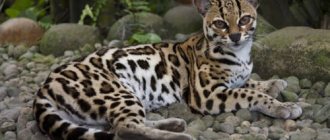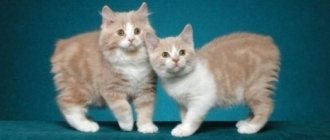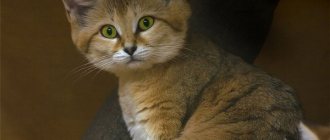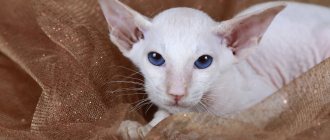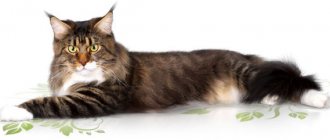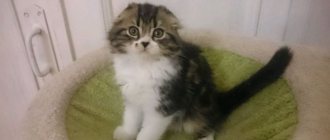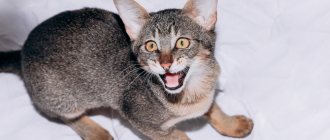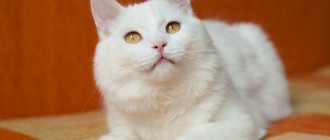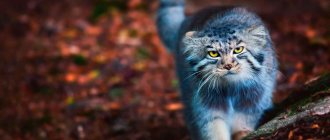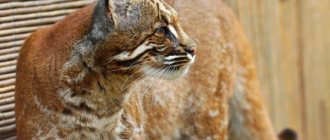History of the discovery of the ALA species
In 1958, Russian scientist Nikolai Severtsov made the first classification of wild cats of Southeast Asia, and in 1917, English zoologist Reginald Pocock confirmed and developed this classification. They divided the Asian or Oriental cats (Prionailurus) into 4 species, one of which was the Asian leopard or Bengal cat. In Latin it is called Prionailurus (Felis) bengalensis, after the name of the region of Bengal in India where Europeans first saw these animals. By the way, R. Kipling’s book “Mowgli” was written about those places. Now this territory - in the delta of the Ganges and Brahmaputra rivers - is divided between India (West Bengal) and Bangladesh (East Bengal). The region has retained its roots; it is inhabited by Bengalis who speak the Bengali language.
The Bengal cat is the most numerous wild cat in Asia.
The cat Prionailurus (Felis) bengalensis has many names: Chinese cat, Ellata cat, Javan cat, dwarf cat, Wagati cat, coin cat, Asian leopard, Far Eastern cat, etc.
The Chinese called this cat “coin” because the spots on its skin resembled the coins that were in circulation in Ancient China.
This number of names is due to the breadth of geographical distribution and the number of subspecies living in different parts of Asia: Indian, Himalayan, Chinese, Far Eastern and others. In total, there are about 20 varieties that differ in color shade and the shape and size of spots: cats living in warm regions with a humid climate have a brighter skin color (yellow-brown with black spots) than those living in the north (yellowish-gray tones with red - brownish spots). All Asian leopards have spots that are elongated horizontally.
Features of character and lifestyle
Photo: Clouded leopard
A body adapted to this lifestyle allows one to achieve these amazing skills. Their legs are short and strong, providing leverage and a low center of gravity. Additionally, the extremely long tail helps with balancing. For gripping, their large paws are armed with sharp claws and special pads. The hind limbs have flexible ankle joints, allowing the leg to also rotate backward.
Research by Dr. Per Christiansen of the Copenhagen Zoological Museum has revealed a connection between these creatures. A study of the skull characteristics of both living and extinct cats has shown that the structure of the clouded leopard is similar to extinct saber-toothed animals such as Paramachairodus (before the group narrowed and the animals developed huge upper canines).
Both animals have a huge open mouth size, about 100 degrees. Unlike the modern lion, which can only open its mouth 65°. This indicates that one of the lineages of modern felids, of which only the clouded leopard now remains, shared some common changes with true saber-toothed cats. This means that animals may hunt large prey in the wild a little differently than other large predators.
Saber-toothed cats would bite at the neck of their prey, using their elongated teeth to sever nerves and blood vessels and wrap around the throat to suffocate the victim. This hunting technique differs from the attack of modern big cats, which grab the prey by the throat to strangle the prey.
Health and life expectancy
In general, the Asian leopard cat has good health and good immunity; it is susceptible to the same diseases as its domestic relatives, but gets sick less often. To maintain health, she is required to undergo regular vaccination against major infectious diseases, good living conditions and proper nutrition. Life expectancy in captivity can reach 20 years.
Most leopard cat subspecies are endangered.
In nature, wild cats have many enemies; in fact, these are increasingly larger predators. Due to the fact that she is dexterous and neat, she is rarely caught. A much greater threat is posed by people who hunt ALC for its beautiful coat. From 1984 to 1989, about 200 thousand spotted skins were exported from China. In 1988, the European Union introduced a ban on their import, but this did not lead to a complete cessation of hunting. Japan continued to buy raw materials. In addition to fur, ALCs are killed by local residents for meat or in retaliation for killed birds. Poachers also catch cats and kittens for sale on the black market to exotic lovers.
Diet
The Asian cat is a predator; its menu contains only animal food. In captivity, you need to feed a leopard cat:
- Lean meat (beef, veal, poultry, rabbit).
- Live food (mice, rats, day-old chicks).
- Low-fat fish.
Feed is given once a day. This rule does not apply to pregnant cats and kittens under six months of age. They are fed two or three times.
The optimal portion for a domesticated predator is 200 grams of meat, one live rat or two mice. Live food is necessary to maintain the normal physical and mental condition of the pet. Dulling of hunting instincts leads to deviations in behavior.
The animal may develop obesity and associated diseases. This leads to the death of the leopard cat.
To prevent obesity, breeders recommend giving your pet fasting days. Once a week the animal is left without food. This will not harm its health, since in captivity the predator spends several times less energy than in the wild.
Fasting days are prohibited for:
- Pregnant cats.
- Small kittens (up to 6 months).
- Sick animals.
Some breeders arrange an additional half-starvation day. The portion for the pet is reduced to half (100 grams of meat and one mouse).
It is recommended to give fish to Asian leopard cats no more than once a week. Its predominance in the diet leads to the leaching of calcium from the animal’s bones and rickets.
If it is not possible to feed your Asian with live food, introduce chicken feet, heads, liver and heart into his diet. This food contributes to the proper functioning of the predator’s digestive system.
In captivity, cats often abandon their kittens. You can feed them by diluting special dry cat milk. Goat's milk or baby formula will do. If possible, it is better to give the kitten to be “fostered” by a recently lambed domestic cat.
Range – where does the snow leopard live?
Habitat of the snow leopard
Since each individual has its own territory from 15 to 200 km, into which other brethren are prohibited from entering, even with a small number, their habitat is quite large.
Snow leopards choose steep mountains as their place of residence, preferring to settle at an altitude of 1500 to 6000 meters above sea level. Depending on the surrounding conditions, the animal can descend into forest areas in search of food or climb to the very tops of rocks.
Now snow leopards are found mainly in Mongolia, Kazakhstan, Afghanistan, Russia, India, China, Tajikistan and Uzbekistan. They can be found in mountainous areas with little snow cover and extensive bushes.
Interesting fact: only 2% of the total number of snow leopards live in Russia.
Evolution
Cheetahs boast some pretty interesting evolution and development. When their population declined sharply during the Ice Age, and the surviving individuals managed to adapt to the surrounding conditions, they needed to restore their numbers. Because of this, inbreeding of related animals began, which gave rise to the effect of homogamy.
Two cheetahs from the same population
Yes, this made it possible to quickly reproduce and populate the planet, but due to the appearance of cubs from close relatives, their gene pool was disrupted. Because of this, the animals are still paying the price. Now almost all cheetahs are so similar in DNA that individuals from neighboring populations may well be considered close blood relatives.
Given this characteristic, it is not surprising that newborn cheetah cubs can have health problems and often do not live beyond the age of one year, facing severe health problems. This is a clear example of how evolution can have a negative effect.
Scientists around the world are trying to find a way to help animals, but so far they have not been able to stop genetic degeneration.
Life of a Sumatran cat in captivity
The life of a Sumatran wild cat in captivity means keeping it in a zoo or nature reserve. In some zoos, flat-headed cats have taken root (even giving birth to offspring). But this does not mean that such success can come to any zoo where a cat is brought. There are many rules in keeping these predators that cannot be ignored. For example, a predator needs to be fed with freshwater fish (preferably swimming in the water).
Life in captivity is like keeping an animal in a zoo
There was a case when a wild Sumatran cat kitten found its way to a local resident’s house. The man hurried to feed the baby meat and milk. Of course, all this was filmed on video, but the further fate of the kitten is unknown. I believe that since these videos did not lead to any “noise” in the press or scandal, then everything is fine with the cat. Most likely, he was fed and given to a zoo or released into the wild.
Video: Sumatran kitten came to a man's house to eat
The wild island cat is rarely seen by humans, so most of the photographs and videos that can be found on the Internet were taken in zoos. Sometimes some events happen in the lives of cats, but the park staff try not to interfere so as not to spoil the conditions that are similar to natural ones. But observations allow us to analyze the characteristics of the cat, and this contributes to the study of the species.
Serengeti
The goal of breeding the Serengeti breed was to create a cat that resembled the wild Serval, but did not contain any of its ancestry. The first Serengeti was created by Karen Sauzman in 1994 by crossing a Bengal and an Oriental cat. Subsequent offspring were crossed with many other types of cats to perfect the breed. However, the Serengeti ancestry includes genes from the wild Bengal cat, which was used to create the domestic Bengal cat. Cats of this breed have long ears and legs, like a serval. They are very mobile, active, and sociable.
Didn't find what you were looking for? Use the site search form
Pet character
The Bengal cat is absolutely not afraid of other pets, even larger than itself. It’s interesting, but not only are they not afraid of dogs, but even from their behavior it’s clear that they consider them their friends! Bengals will play with the dog, jump, scratch and bite it, apparently, the gene for fear of dogs has finally been eradicated. Or is it just their innate bravery - we can only guess.
The cat has a very interesting voice, unlike the standard meow. Its sound simultaneously contains threatening, predatory notes and soothing tenderness, even a slight chirping can be traced, like that of birds. And Bengals scream loudly, persistently, be prepared for concerts during puberty.
Like dogs, the Bengal breed is capable of training and remembering commands. He will look at you with intelligent eyes, listening carefully to every word. For example, it is not difficult to teach a Bengal to carry things with its front paws while moving on its hind paws. Don't be surprised if one day the purr opens a door or closet by the handle, turns on the light at night, or flushes the toilet.
Let us once again emphasize their endless playfulness. A cat, sensing the owner’s bad mood (they have very developed intuition), or if a person is sick or depressed, will undoubtedly bring him a toy and invite him to play in order to distract him from bad thoughts.
If a cat lies on the owner’s sore spot, giving healing warmth, then the Bengal will call to play, such a cheerful character.
And remember - we are responsible for those we have tamed!
Care and maintenance
Bengals do not require any special care. The cat should be vaccinated regularly, given anti-parasitic tablets, monitor its diet, play and bathe as needed.
Hygiene
For the procedure, you can use wet baby wipes or a piece of cotton wool soaked in tea leaves or a special zoo lotion. The latter helps to cope with dark spots in the corners of the eyes of snowy and white Bengals.
Bengals do not require special care
Lotions for cats that relieve inflammation and remove ear mites are suitable for cleaning the ears. If the inside of the ear dries out, it is recommended to treat it with baby moisturizer. Brown or gray discharge is a reason to consult a veterinarian.
The Bengal does not need to specially trim or file its claws. The cat constantly wears down the claws on his front paws on a scratching post or rug, and chews on his hind paws.
The cat washes itself several times a day, combing out any loose hairs. This promotes the growth of new fur. Therefore, you should not bathe your pet unless absolutely necessary. But regular brushing improves skin regeneration, removes dirt and matted hairs, preventing the accumulation of hairballs in the animal’s stomach.
They bathe a Bengal cat if it gets dirty or to get rid of parasites. If the pet is sick, bathing is prohibited, as the procedure can provoke the progression of the disease.
The cat washes itself several times a day, combing out any loose hairs.
Diet and feeding
Bengals have a weak digestive system. Therefore, they need special nutrition. There are two types of food - natural or prepared (wet kibble or dry kibble).
Feeding your pet food from a human table is unacceptable. Spices, sweets, fatty and high-calorie foods are harmful to the cat.
Kittens up to 4 months of age are fed six times a day, from 4-6 months - four times, from 6 months to a year - 3 times. For adults, two meals a day is sufficient.
If there is any uneaten meat or prepared wet food left in the bowl, it should be thrown away. After eating a spoiled product, your pet may become poisoned. The exception is ready-made dry food. It can be left for a day.
Be sure to read:
Toyger cat - a breed similar to toy tigers, description and character of a tiger cat
Education and training
The Bengal cat is a bundle of energy; active games with the owner are important for him. A great option is hide and seek or chasing a rustling candy wrapper tied to a string.
Spending time together will increase mutual affection. Bengals are very sociable. They will be happy to “talk” to the owner.
When raising a kitten, it is worth teaching it the word “no”. To reinforce the prohibition, you can use a squirt gun or water gun.
Life expectancy and typical diseases
When raising a kitten, it is worth teaching it the word “no.” The maximum age that Bengals live to is 13-16 years. Life expectancy depends on genetics, nutrition and maintenance. Cats of this breed are hardy and healthy.
But they may have genetic diseases - cardiac pathologies, which can cause death. Bengal cats are also susceptible to gastrointestinal infections, poisoning and feline leukemia.
Castration and sterilization
Sterilization and castration is a humane choice for an owner who does not plan to breed. During the operation, the male's spermatic ducts are tightened or the testicles are removed.
For females, medical, radiation and surgical sterilization is offered. The optimal solution is surgical removal of the animal's uterus and ovaries.
Description of the appearance of the steppe cat
All three subspecies of steppe cats differ in appearance. Characteristics of the African Steppe Cat:
- Coat color ranges from gray-yellow to brown-sandy or sandy.
- Pattern: tabby mackerel (striped).
- Distinct wide black stripes on the tail and legs. The stripes on the body are reddish or brown, indistinct and barely noticeable.
- The coat is short, with sparse undercoat, soft, and does not fit tightly to the body.
- Body length can be from 45 to 75 cm.
- The tail length varies from 20 to 38 cm.
- Weight - from 3.5 to 6.5 kg.
- The cat's legs are twice as long as the width of the body, thin and slender.
- The cat's head is medium in size, gracefully set on a muscular, rather long neck.
- The ears are large, wide, with rounded tips, set high and straight, slightly tilted forward.
- The eyes are large, almond-shaped, green or yellow.
Asian steppe cat:
- The color of the coat is sandy, brownish, and may have a grayish or reddish tint. In general the color is lighter and warmer than that of Fs lybica.
- The coat pattern is spotted tabby.
- Small black spots with clear contours are located in random order on the fur. There are distinct stripes on the legs and tail.
- The coat is short, smooth, soft, almost devoid of undercoat, and does not lie very tightly to the body.
- Body length - from 47 to 79 cm.
- Tail length is 30–40 cm.
- Weight - from 3.5 to 7 kg.
- The legs are shorter than those of Fs lybica and more muscular. The frame is also heavier.
- The head is round, small or medium, the neck is short and muscular.
- The ears are small, wide, rounded at the tips and set wide apart.
- Large, almond-shaped eyes can be green, yellow or amber.
South African steppe cat:
- The color of the coat can be iron-gray with a reddish tint, red-gray with a tint of ocher.
- The coat pattern is mackerel or spotted tabby.
- Dark brown or black stripes cover the legs and tail. Reddish or brownish stripes or spots on the body are pale and almost invisible.
- The coat is thick, short, with a rather thick undercoat, soft, smooth.
- Body length - from 45 to 70 cm.
- Tail length is 25–38 cm.
- Weight - from 3 to 6 kg.
- The legs are strong, muscular, and quite long.
- The head is medium size, rounded, graceful. The neck is short and muscular.
- The ears are large, their height varies from 6 to 7 cm. The tips are rounded.
- The eyes are medium or large and can be light green or light yellow.
Origin of the species and description
British naturalist Edward Griffith first described this feline in 1821, giving it the name Felis nebulosa. In 1841, Brian Haughton Hodgson, exploring the fauna in India and Nepal, based on a description of a non-Polish specimen, named this species Felis macrosceloides. The following description and name of the animal from Taiwan was given by biologist Robert Swinhoe (1862) - Felis Brachyura. John Edward Gray collected all three into one genus Neofelis (1867).
The clouded leopard, although it represents a transitional form between small and large cats, is genetically closer to the latter, belonging to the panther genus. Previously considered as one predator, it was split into two species in 2006.
Appearance and features
Cheetahs grow up to 140 cm in length and have a slender build with pronounced muscles that are visible even through thick fur. The head of an adult is approximately 90 cm from the ground. The body of predators practically does not store fat so that it does not interfere with hunting.
Cheetah resting in the sun
The cheetah's head is quite small in relation to the body and is connected to it by a long neck. The eyes are large and located quite high. The ears are round in shape and located on the sides of the head. The nose and jaw are slightly extended forward. Scientists suggest that such structural features provide aerodynamics and minimal resistance when running.
History of the origin of the breed
The Bengal cat is the result of a one-of-a-kind successful combination of a wild cat and a domestic cat. The breed has a founder - a female breeder Jean Sudgen (Mill). D. Sudgen conducted experiments on crossing a wild Asian leopard cat with a domestic one in the 70s of the 20th century.
The result of many years of painstaking work has become a new breed - the Bengal (domestic) cat, which amazingly combines the wild features of its ancestors with the friendliness and tenderness of domestic pets.
The world community of felinologists did not immediately accept this breed. The International Cat Association did this in 1991, and the Cat Fanciers Association still refuses recognition of the hybrid breed.
Burmilla
Burmilla breed history: In 1981, the British breeder of Russian Blue cats Miranada Bickford-Smith (von Krichberg) bought a Persian chinchilla named Jemari Sunquist for her husband. He was supposed to be castrated, but the cat turned out to be more efficient than his owners, and therefore, before the operation, he managed to start an affair with Miranda’s European Burmese - Bambino Lilac Faberge. As a result, four charming cats of Burmese type and chinchilla color were born. These were the first Burmilla (Burmese + chinchilla). Miranda really liked the cats, and she and her friend Teresa Clark (Cartouche) began to develop a new breed. At the same time, Teresa focused exclusively on black chinchilla-colored Burmillas, and Miranda continued to experiment and had a hand in the formation of almost all Asian breeds. She even founded the Burmilla and Asian Cat Association in 1985, which is now called the Asian Group Cat Society AGCS.
Reasons for the decline in numbers
In addition to extremely slow reproduction and population replenishment, the reason for the disappearance of the Far Eastern leopard was barbaric human activity.
Forests and territories suitable for hunting grounds for predators. They are rapidly declining under the onslaught of civilization, plus forest fires “help” by destroying vegetation and forcing herbivores to migrate.
This also includes highways and railways laid through age-old forests, plowing of land for fields, and uncontrolled cutting down of trees for logging.
Poachers who poison the animals with packs of dogs cause enormous harm to the small population of Amur leopards. Hunters strive to obtain the valuable skin of a beautiful animal, and Chinese healers pay more money for parts of the carcass used in the manufacture of potions.
Sometimes Far Eastern leopards become victims of deer park owners. Predators trying to get food for themselves are shot right at the scene of the “crime.” Very rarely, careless leopards are hit by cars passing along the highways.
Find out all the nuances of keeping a cat
Kittens, tamed from early childhood, can live with humans. Animals older than three months of age are practically not amenable to domestication.
If you do not plan to breed an Asian leopard cat, kittens should be neutered before puberty. It is optimal to do this at 5-7 months. In mature, uncastrated animals, the character changes for the worse. They become poorly managed.
Leopard cats are active and need space and the opportunity to play. You cannot keep your pet locked up. This will have a bad effect on the physical and mental health of the predator.
Asians living in apartments need to be walked just like dogs. In winter, animals will need special clothing for walking. Their coat is not adapted to cold weather.
On average, leopard cats should spend 6 hours on physical activity and play. It is better to have two pets at once. This will save the owner’s time on entertaining the domestic predator.
Photo gallery: Asian leopard cats
The Far Eastern Asian cat is listed in the ALC Red Book and reacts with a hiss to everything new and unusual. Asian leopards mainly hunt at dusk and at night, but can do this during the day. Far Eastern (Amur) cats live in our country in the taiga in the Far East. The Far Eastern Asian cat slightly different skin color, longer hair and close-set small eyes compared to ALC from the southern regions Small Asian leopards are as cheerful and playful as ordinary cats When keeping ALC in enclosures, they try to create an environment close to natural - with ponds, trees and definitely a shelter, heated in winter
Keeping an Asian leopard cat in a city apartment is possible only if the owner has a lot of free time, patience, effort and material costs, and above all, a strong desire to keep a predatory cat from the forest in his home. At the same time, a successful taming result cannot be guaranteed, because such a pet remains a predator whose behavior is based on instincts. It is more expedient to keep ALC in country houses by equipping special enclosures for them. Before purchasing a wild Bengal cat, it will be useful to inquire about the legislation in this area, because in some countries certain types of ALC are protected, and keeping them at home is punishable by law. There are no such prohibitions regarding hybrids of wild and ordinary cats, and the easiest option is to take a closer look at the domestic Bengal breed, whose representatives are no less beautiful than their wild ancestors, but at the same time are much more adequate in communicating with people.
Population status
Currently, the Amur forest cat is included in the Red Book. The exact number of cats of this subspecies is unknown today. According to rough estimates, it does not exceed two and a half to three thousand individuals.
According to the generally accepted point of view, the number of Amur cats has decreased by at least a third. Part of the responsibility for the sharp decline in wild cats lies with humans themselves, as they are involved in:
- plowing virgin soil;
- cutting down bushes;
- setting fire to stakes (small forests in the fields).
Many representatives of the subspecies fell into hunting traps and snares, originally intended for hares. Uncontrolled natural fires also played a destructive role.
All the negative factors described above led to the fact that in 2015 there were only a few thousand Amur forest cats.
Prevention of extermination
Thanks to the efforts of animal rights activists, a significant fine was introduced for the destruction of Amur cats, reaching several thousand rubles. In the near future, it is planned to systematically inform local residents, especially hunters, about rare representatives of the local fauna, as well as about the usefulness of wild cats in the fight against rodents. Also, Far Eastern cats are under vigilant supervision in Japan, where about fifty representatives of the subspecies live.
Reserves
It is difficult to overestimate the contribution of protected areas in the regions, which provide greater safety for animals. The list of such territories includes
- Land of the Leopard National Park;
- Kedrovaya Pad Nature Reserve;
- Bolshekhehtsirsky Nature Reserve;
- Lazovsky Reserve;
- Khanka Nature Reserve;
- Ussuri Nature Reserve.
Zoos
The Far Eastern leopard cat is a rare guest in zoos. It is mainly kept in zoos in China and Japan, but in Russia there are several places where this animal lives, for example, the Barnaul Zoo.
They say that Amur cats do not live in zoos, but simply die for a long time
There are several reasons for such a low prevalence of the Amur cat. Firstly, catching a wild cat specifically for collection is not an easy task. That is why the Amur cat was and remains one of the most poorly studied subspecies.
Secondly, leopard cats languish in captivity. Even in a zoo, where no one and nothing threatens the cat, the wild animal remains wild and extremely cautious. As a rule, he builds a hole for himself or uses an already prepared one, only occasionally coming into contact with people and other inhabitants.
When surrounded by people and other animals, cats remain withdrawn and cautious.
Despite the unadaptability of wild cats to life in a cage, in zoos and enclosures the life expectancy of representatives of the subspecies is 17-18 years, while in the wild they are given 10-12 years. However, there are a variety of assumptions about the number of years allotted to a forest cat by nature. Some argue that 18 years is not the limit.
Taming the Far Eastern forest cat
Since Amur cats are only slightly larger than the usual domestic cat and look about the same, many exotic lovers have an irresistible desire to own such a fluffy cat. The only difficulty is that the blood of wild predators flows in the veins of this mustache. And the call of the ancestors can wake up at any moment.
Amur cats are almost impossible to train
Far Eastern forest cats are independent and willful
Not a single attempt to tame or train these furry predators has been successful. Moreover, such undertakings often ended in injury to the “trainers.” After all, if it is impossible to escape from people, the Amur cat instantly turns into an aggressor. And as you know, the fearlessness of an angry mustachioed cat knows no bounds.
A friend works as a huntsman in the Far East, he once picked up such a kitten (the cat died, most of the kittens too, this one survived) very small, still a milky one, he was completely exhausted, almost dead, well, he came out, fed him, he grew up and went to live in the forest has not taken root in the house, but it comes to visit regularly, it will come, eat it for free and leave, it will not be allowed into the hands of anyone, not even Yegor (the huntsman).
When purchasing a Far Eastern forest cat to live at home, you need to remember the following:
- such a kitty does not go “in your arms”;
- wild murka does not eat “from the palm of your hand”;
- the spotted cat will sleep during the day and wander around its assigned territory at night (if not retrained);
- During the mating period, aggression will intensify, which is why the animal can fill the house with heart-rending screams.
It is also important that even individuals taken at three months of age become wild as they grow and strive to return to their natural environment by any means.
Conditions of detention
Since this animal is listed in the Red Book, the official sale of Amur forest cats into private hands is prohibited. However, there are cases when animals still end up in the same home with a person - given by a zoo or picked up by a familiar hunter. Cases of smuggling are also not excluded. And then the owners need to decide on the living conditions of the wild predator in the house or even apartment.
It is advisable to keep Far Eastern forest cats in closed enclosures
Experts unanimously recommend limiting the living area of the Far Eastern forest cat to a spacious enclosure. It should have devices for climbing and jumping (beams, tree trunks and cuts, shelves), as well as a convenient “nest”. This can be made in the form of a house like a doghouse. In addition, you need to take care of the pet’s tray by filling the “toilet” with sawdust or sand.
Best articles: How many species of animals inhabit our planet?
Important nuance! According to Russian legislation, keeping Red Book animals in captivity, including Amur forest cats, is punishable by a fine of up to 1 million rubles. or forced labor for up to 3 years.
Lives great at home!!!!! Yes, he doesn’t often sit on his lap and purr, but ROARLS! But he feels great in the apartment and eats his mice and birds and meat. We got here by accident - the zoo didn’t accept us!!!! It was a pity to give it away to someone unknown! Stayed and feel great in a Moscow apartment! Doesn't tear up wallpaper, doesn't shit anywhere! It marks, but this issue has also been resolved - we put protective glass in the places where it marks - we remove it and there are no problems!
In the wild, Far Eastern cats cannot always afford to consume food every day. This is worth remembering when dealing with an animal that has come to a person as a pet.
Wild catfish from the banks of the Amur should be fed once a day, preferably at the same time. The diet should include poultry, lean beef, veal and rabbit
To maintain dental health, it is important to feed the animal mice and uncut bird carcasses.
In addition, once a week you can pamper your pet with the following food:
- raw chicken or quail eggs;
- sea fish (both fresh and boiled);
- boiled vegetables (pumpkin, carrots, zucchini).
But you shouldn’t give porridge to your pet - they can cause fermentation in the intestines and disrupt the functioning of the digestive system. You should also exclude milk, bakery products, alcohol, spices, fried and salty foods from the menu.
Animals must have access to clean drinking water.
Amur forest cats are difficult and brave animals native to the Far East. These animals have been cherished for a long time, and for lovers of exotic fluffy beauties they become a desirable trophy in the home nursery. However, we should not forget about the negative aspects of keeping a Far Eastern cat at home - the aggressive behavior of the purr and criminal liability for owning a Red Book animal.
I write articles on various topics
Life in captivity
The main knowledge of zoologists about the Chinese mountain cat is based on observations of the animal not in its natural habitat, but in captivity. Thus, in the zoo in Xining (China), more than thirty animals were studied for twelve years, which provided a wealth of material for scientists. But these data may not fully reflect the natural behavior and lifestyle features of this little-studied species.
Features of care
Chinese mountain cats are unsociable, capricious and aggressive; This species is completely unsuitable for keeping in apartment conditions. Any attempts to tame wild animals are doomed to failure, even if the kittens were taken from nature when they were very young.
The Chinese mountain cat tolerates captivity well, but is never tamed
Pets must be vaccinated. In childhood, comprehensive vaccination is carried out at eight and twelve weeks, and then repeated annually, along with rabies vaccinations.
Video: this is how a rare animal is sold at a Chinese market
The fashion for keeping exotic wild cats in captivity has done a disservice to an already vulnerable species. The Chinese mountain cat has become the object of smuggling trade, despite international legal prohibitions. You need to remember that this animal is absolutely not tamed - and only after that should you consider purchasing it.
Lifestyle and behavior
Foxes prefer to live in packs
Foxes prefer to live in packs consisting of an older male, a female and their cubs. In fact, these predators live in full-fledged families. As a home, they choose an area where there is enough food and there is loose soil for digging holes. Foxes live in the latter, and sometimes they can occupy a hole made by another animal. Cases have been recorded when predators inhabited part of the underground tunnels made by badgers and existed side by side with them without entering into conflict. When inhabiting a territory, foxes can dig several holes leading to one nest located underground.
If for some reason a fox lives alone, it may not dig a hole at all, using thick grass, snowdrifts, etc. as a place to sleep.
In its lifestyle, the predator is largely nocturnal. Possessing excellent eyesight, he has excellent orientation in the dark, which allows him to track down prey. When going hunting, the fox prefers to move in a straight line so as not to go astray.
Parasitic bees
Among bees there are entire subfamilies of kleptoparasites - insects that appropriate other people's nests and food. In other words, they live off the labor of other bees. They are called cuckoo bees due to their similar behavior to birds of the same name.
Neon cuckoo bee
In such species, the body is not sufficiently developed to collect pollen and nectar. They also do not build nests. Instead, insects throw their eggs into other people's homes. When a kleptoparasite larva appears, it can destroy other larvae and all food. Sometimes such bees destroy the queen of the colony, and themselves settle in the nest.
Where do leopards live?
Leopards live over a vast territory - in Africa (except the Sahara), in central and southern Asia (Nepal, India, Bangladesh, Bhutan, Pakistan, Sri Lanka), as well as in northern India, southern China and the Korean Peninsula. In Russia, this predator can be found in the Caucasus and Primorye. Of the entire cat family, the leopard has the largest habitat.
The animal's natural habitat is dense tropical, subtropical and mixed forests, savannas and plains, mountain slopes, and thickets along river banks. Leopards live successfully both in warm tropical conditions and in northern deciduous and coniferous forests. They are practically not found in deserts and arid areas.
Predators usually live alone and have their own territory. The area of one's own territory depends on the biomass density, that is, on the amount of potential prey, and on the terrain. In arid regions with low biomass density, the size of an animal's own territory will be several times larger than in a forest or mountainous area. Predators with large territories often have cross-territories with their neighbors. Females often share their territory with their female offspring, but older males usually move away from their mother's territory.
Nutrition
In terms of food, the forest cat is also a gourmet and a glutton: he prefers to eat fresh prey; his daily diet can consist of a dozen small rodents. An adult can consume up to a kilogram of food daily.
Best articles: Chelicerates - description, characteristics, nutrition and classification
The victims of cats are:
- field mice
- Sony
- partridges
- pheasants
- coots
- gray rats
- muskrats
- trout
- nutria
- rabbits
- moles
- squirrels
- shrews
- caresses
- martens
- lizards
Once upon a time, cats living in the steppe regions caught bustards and even eagles; sometimes a large individual can defeat a small roe deer. Predators living on the banks of rivers and the inhabitants of floodplains hunt for fish and aquatic animals.
When approaching human habitation, cats free the surrounding area from the rodents that have settled there. While helping people in this way, they are doing harm at the same time by eating poultry. They cause harm to wildlife by destroying rare birds in protected areas (for example, in the Caucasus).
The meal process resembles that of an ordinary cat, but the front paws do not fall to the ground. It chews its prey, biting off one piece at a time, starting from the side of the carcass.
Origin of the species
It was initially believed that the first ancestors of the snow leopard appeared during the Pleistocene era, which ended 11.7 thousand years ago. However, remains were later found that were between 1.2 and 1.4 million years old. This suggests that predators appeared on the planet much earlier.
The ancestors of cheetahs appeared approximately 1.5 billion years ago.
Scientists are still arguing about which family snow leopards belong to. At the moment, they are classified in the genus Uncia, which designates animals that have characteristics of large and small cats at the same time. For example, the skull structure of a snow leopard resembles that of a regular cat, but has a hyoid bone, which is characteristic of panthers.
Interesting fact: currently only snow leopards belong to the genus Uncia, since they are the only creature that has the characteristics of medium-sized cats. Moreover, this classification was invented specifically for them.
Since the snow leopard resembles a leopard in appearance, they have long been considered relatives. But detailed studies have proven that they have no family ties. But the snow leopard has a clear relationship with all types of panthers. It was later proven that snow leopards appeared approximately 1.67 million years ago and descended from the ancestors of today's tigers.
Some scientists have proposed dividing Uncia into subspecies, since the predator has a wide habitat. But more detailed studies have shown that at the genetic level, two snow leopards living in different places are no different and are representatives of the same species.
History of the discovery of the ALA species
In 1958, Russian scientist Nikolai Severtsov made the first classification of wild cats of Southeast Asia, and in 1917, English zoologist Reginald Pocock confirmed and developed this classification. They divided the Asian or Oriental cats (Prionailurus) into 4 species, one of which was the Asian leopard or Bengal cat. In Latin it is called Prionailurus (Felis) bengalensis, after the name of the region of Bengal in India where Europeans first saw these animals. By the way, R. Kipling’s book “Mowgli” was written about those places. Now this territory - in the delta of the Ganges and Brahmaputra rivers - is divided between India (West Bengal) and Bangladesh (East Bengal). The region has retained its roots; it is inhabited by Bengalis who speak the Bengali language.
The Bengal cat is the most numerous wild cat in Asia.
The cat Prionailurus (Felis) bengalensis has many names: Chinese cat, Ellata cat, Javan cat, dwarf cat, Wagati cat, coin cat, Asian leopard, Far Eastern cat, etc.
The Chinese called this cat “coin” because the spots on its skin resembled the coins that were in circulation in Ancient China.
This number of names is due to the breadth of geographical distribution and the number of subspecies living in different parts of Asia: Indian, Himalayan, Chinese, Far Eastern and others. In total, there are about 20 varieties that differ in color shade and the shape and size of spots: cats living in warm regions with a humid climate have a brighter skin color (yellow-brown with black spots) than those living in the north (yellowish-gray tones with red - brownish spots). All Asian leopards have spots that are elongated horizontally.
Life in captivity
The smallest cats can be kept in captivity and are very easily domesticated. Cats are highly tamed and have a friendly and affectionate disposition. Pets become very attached to their owner. The local population of India sometimes keeps these cats as pets. They are also kept in zoos, but their numbers are extremely small.
Rusty cats can be kept in captivity
The fact that wild cats are easily tamed is very unusual. Almost all cats retain some wild habits when kept at home. A forest kitten that came into our house a long time ago did not want to get to know us, despite all the efforts made. He hid under a cupboard and stubbornly refused to eat. We tortured him for a couple of weeks and then returned him to nature. But it was extremely difficult to pull him out of the gap; he bit and scratched wildly.
Features of care
It is not difficult to keep rusty cats in captivity; they are not particularly whimsical. They do not pose a particular threat to humans due to their small size. But you need to feed the miniature predator mainly raw meat. As a last resort, high-quality dry food can be used. Be sure to include vitamin and mineral supplements in your diet.
When keeping rusty cats in a zoo, you need to create conditions close to natural ones.
When kept in a zoo, animals are provided with spacious enclosures with shelters, ladders, branches, stones and other objects that imitate their natural habitat. However, animals behave differently than in the wild. They sleep at night and are awake in the morning, afternoon and evening hours. These cats rarely produce offspring in captivity.
In 2012, kittens were born to a rusty cat at the Berlin Zoo.
A few years ago, a female gave birth to two kittens at the Berlin Zoo. This event occurred for the first time in the history of this institution. Distant relatives live in Germany and were seen when visiting the Berlin Zoo. They say that they have never seen smaller and cuter wild cats. Kittens seem like toys, they are so tiny. But at the same time they are very active and restless. Mother cat kept a vigilant eye on them and carried them pieces of meat. To appreciate the exclusivity of the event, one must take into account the extremely small number of this feline species.
Lifestyle of the Sumatran cat
Sumatran cats spend most of their time near water. It is easy to find such a cat in wetlands, near rivers and in coastal forests. They are sometimes found on oil palm plantations. It is assumed that Sumatranks, like any other cat, maintain territory using olfactory “markers.”
This cat apparently sleeps during the day. Most likely, she chooses a place to sleep also not far from the water, but on some kind of hill (for example, on a snag). Accordingly, it is more convenient for her to hunt during the day. In daylight, fish can be seen better through the water. The cat gets into the water, feels the bottom with its paws and tries to track down its food.
Flathead cat nutrition
The main food of the Sumatran cat is fish and frogs. If a cat can catch a shrimp, then it will not refuse such a delicacy, but it will not disdain rodents either. Sometimes it happens that an animal manages to catch a poultry chicken. However, such a cat can hardly be called a wild animal. The fact is that Sumatrans are omnivores. They can dig up the ground and get edible fruits from there. This is how cats eat, for example, sweet potatoes.
It is also curious how the cat catches fish and frogs. Sumatranka can immerse its head in water to grab prey with its teeth. The people who managed to place this cat in an artificial environment conducted research. The cats were offered sparrows in cages and frogs. The choice of predator fell on amphibians. Wherever the cat caught a frog, it always carried the victim 2 meters from the place where the unfortunate thing was caught.
Flat-headed cats prefer to catch their prey out of the water.
And also, when swimming in the pool, flat-headed cats spread their front paws widely (like raccoons). And if you show a cat a mouse on the shore and the same mouse, but swimming in the water, then the predator will choose the second option. Since all the cat's food consists of small animals or fruits, it feeds as it gets hungry. However, hunting for a cat is not only about catching food, but also about satisfying its hunting instincts.
Reproduction
Puberty in Sumatran wild cats occurs at 8–10 months. Presumably, the mating season occurs between January and February. These cats do not have a strictly fixed breeding season. Pregnancy lasts up to 2 months. One litter can have up to 3 babies. Predator cubs become independent by 10 months. At this time, the kittens try to leave their mother. Some babies try to leave the family earlier (at the age of 6 months).
The reproduction of flat-headed cats is still poorly understood
The cat lets her babies go only when she is sure that they have already learned to fish.
Island cat teaches her kittens to catch fish and frogs
Lifestyle
Their habitats are:
- tropical or pine forests;
- semi-deserts;
- area near rivers;
- territories located at an altitude of 3000 m above the ground.
Wild Asians build their homes in:
- tree hollows;
- caves;
- dens.
In their natural homes, Asian cats mostly sleep during the day, as they are nocturnal, hunting for other animals, because they are predators. To do this, they easily climb to the tops of trees, hoping to find food there, which for them is:
- small birds;
- proteins;
- tree shrews.
INTERESTING TO KNOW: Why are there so many cats in Cyprus?
These cats often live near bodies of water, so their diet may include various members of the amphibian family. They feed on insects, mammals, and lizards.
If desired and necessary, they can swim in rivers, climb mountains, even climb rocks. These predators are usually solitary. They are rarely seen near human habitation. They prefer to spend time in pairs only during the mating season, after which 2 or 3 kittens are born.
A pair of cats that have offspring usually raise children together for 8 months. Evidence that kittens are predators is the presence of fangs within a month after birth. By this age they are ready to taste solid food.
Habitat
In the wild, the clouded leopard lives in tropical and subtropical forests of south-eastern Asian regions: in the south of China, in Malacca, its habitat extends from the foothills of the Himalayas all the way to Vietnam; many individuals live in Bhutan, Bangladesh and the vast expanses of Thailand. Once upon a time, there was even a separate subspecies in Taiwan - the Taiwanese clouded leopard, but, to the chagrin of many cat lovers, it has long since become extinct.
In addition to dry forests, this animal is often found in swampy areas, but there it spends most of its time not on the ground, but prefers trees, where it is drier and there are fewer biting parasites.
Description of coins
On the obverse of each denomination there is a traditional image with wings “looking” down, under it there is the inscription “Bank of Russia”. Around the frame of dots, the denomination of the coin, the hallmark with the designation of the metal, the year of minting and the sign are written. The reverse depicts a leopard in various poses and actions. The background is decorated with the outlines of nature. At the bottom, each coin “Nast Asian leopard” - 11 has the inscription “Let’s save our world” along the edge.
The Leopard Cat or Asian leopard cat is a wild cat breed that is native to the Indian subcontinent and Southeast Asia. Today, eleven subspecies of this breed are known, but its name has nothing to do with leopards and is explained by the presence of characteristic spots on the fur. One of the subspecies of the Asian golden cat is known as the Temminka. These animals with black, gray, golden or red colors live in the foothills of the Himalayas, Malaya, and also Sumatra.
The wild highland Asian shorthair cat is quite large in size compared to domestic cats. An adult animal can weigh up to fifteen kilograms. Their color depends on the region where they live. In the southern regions, animals have a lighter color. Fishing cats or Asian fish cats are smoky in color and have even shorter fur. They got their name from their characteristic way of life. These animals swim well and feed on fish that they catch on their own.
In the wild, Asian cats typically give birth to no more than two to four kittens, and pregnancy lasts about 65 days. The cat feeds the babies for about five weeks until their fangs grow. If the offspring do not survive, the cat may produce another lamb within a year.
Asian wild cats feed on small rodents, mammals, amphibians, insects and birds. Some species expand their diet to include grass, fish and eggs.
All subspecies of wild Asian cats are excellent climbers. Any height is not a barrier for them. In addition, these animals are excellent swimmers, but they swim extremely rarely. The exception is the fish cat, which leads a semi-aquatic lifestyle.
Leopard cats are nocturnal, and during the day they sleep in hollows, dens, caves and other places hidden from view, as well as in areas where there are no people. Only during the mating season can these animals be seen in a group. Often, a cat chooses a male cat, mates with him, and after another ten to eleven months the couple lives together. When the kittens become independent and can eat solid food, the male leaves the den.
If animals live in the natural environment, then sexual maturity occurs at one and a half years. In captivity, these cats mature earlier. Males are ready to mate already at seven months, and females - closer to the tenth month.
